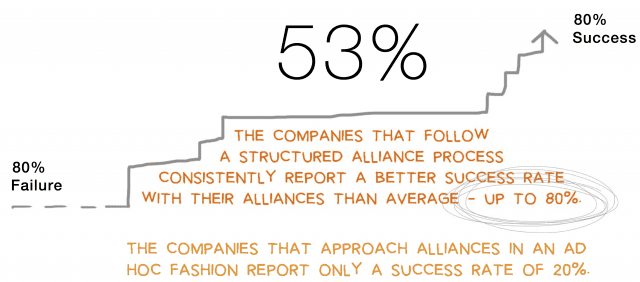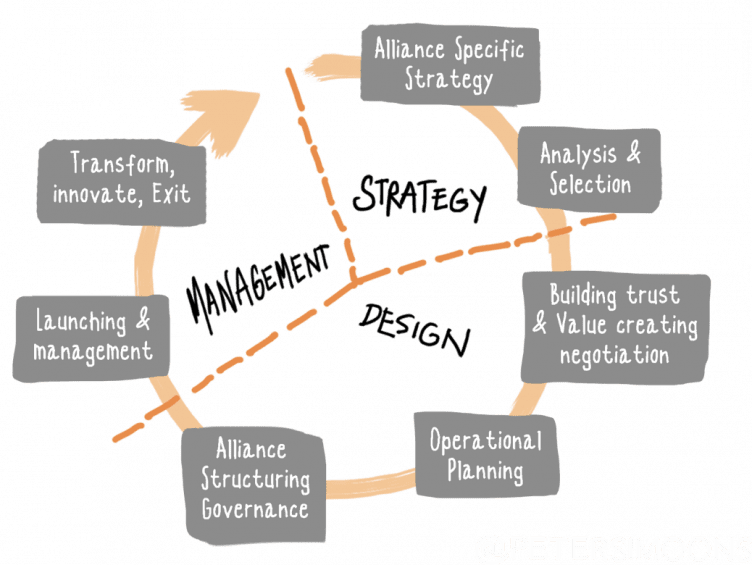Tip 14: Prepare Your Partnership by Following a Structured Alliance Process
Remember how we mentioned earlier, that you need to be in the winning side of the 80% rule if you want your partnership to succeed? The fact is 80% of ad hoc unstructured business partnerships fail, while 80% of the companies that follow a structured alliance process towards creating partnerships emerge successful.
Would your company invest in something that you know will have a four out of five chance of failure?
Most of the time, the 80% failure rate contains the companies who create alliances in an ad hoc fashion and dive into opportunities for alliances in a chaotic, unstructured way.

However, there is another side to the 80% rule, and that is the success side. The companies that follow a structured approach to establishing and managing alliances and other business partnerships reach a success rate of up to 80%. These companies have made investments in building up skills and competencies before approaching alliances. Subsequently, they create and manage alliances in a structured way, often based on the alliance life cycle methodology.
The value is obviously in the success side of the 80% rule, while no value is created on the 80% failure side. In fact, failure may even destroy value. A partnership is created to achieve a goal you cannot achieve easily alone. The partnership has to become valuable and successful to be truly worth the effort.
Following a structured alliance process may sound cumbersome to some people. For many, the words “structured” and “process” feel like an endless exercise where no room for creativity is left. To be honest, I have been among them, but I have learned that a structured process does not have to be like that. A structured process can be an umbrella process that guides you through the essential steps of creating a partnership. It saves you time while safeguarding quality in the end.
Many large companies that have entered into successful alliances have documented their processes. Often supported by academia, these processes usually consist of six or seven main steps. The Association of Strategic Alliance Professionals (ASAP) captured the best practices of their members into a seven-step strategic alliance process. These seven steps are the main steps you should follow, and they are often subdivided into smaller underlying steps.
Large companies in general have more bandwidth and manpower to follow the steps of such an extensive process. Following these steps is definitely necessary when creating the alliance involves more than one department. For instance, departments that have their say on legal and intellectual property will be part of the alliance formation. But for smaller companies, since they often don’t have the bandwidth or the need for such an extensive process, only a simple yet comprehensive process is required.
This is the complete, seven-step structured alliance process as described by ASAP:

- Step 1: Alliance-specific strategy
- Step 2: Analysis and selection
- Step 3: Building trust and value creating negotiation
- Step 4: Operational planning
- Step 5: Alliance structuring and governance
- Step 6: Launching and management
- Step 7: Transform, innovate and exit
In working with clients, I generally split this large and extensive process into three main steps that nonetheless cover the essentials for building successful alliances. These three steps are:
- Strategy
- Planning
- Operation
In strategy, we check the strategic rationale and answer the question of whether partnering is the right choice for the solution the company wants to implement. This step also contains the partner analysis and selection. Many small business owners will be hesitant to do this exercise, as they might feel that they already know the answers. Still, it is important to do these sanity checks on plans and partners, and these checks do not have to take long.
In the planning phase, we negotiate the contract with the partner and jointly set the planning for the partnership. The business plan will be defined and the kickoff of the alliance will be scheduled.
The kickoff is the actual start of the alliance and the start of the operational phase. In this phase, the partnership or alliance will need to be managed to deliver according to the agreed KPIs and to reach the goal that the partnership envisioned.
As said, for some people, a structured process may sound cumbersome, but it can be followed in a pragmatically applied fashion. In a recent engagement with an entrepreneur, it took us less than 15 minutes to validate his strategy and choice for partnering. Subsequently, we went into partner analysis, which took longer and resulted in some surprising conclusions for the entrepreneur. The outcome was not what he had expected, but thanks to a thorough process, he was making solid decisions on how to go forward and with which candidate partner.
Even when you already have a partner in mind, or even when you are already approached by a partner, it is good to do the analysis. This will help you become aware of potential elements that may require additional attention during the alliance’s operational phase.
Following a structured process will help you create the roadmap to successful partnerships.
I am publishing my ebook “25 tips for successful Partnerships and Alliances” in parts here on my website. Every other week a tip from the book will be shared, in the weeks in between I will publish my regular column. If you prefer to read the tips in the ebook faster rather than wait a full year then click here to purchase your own copy of the book.